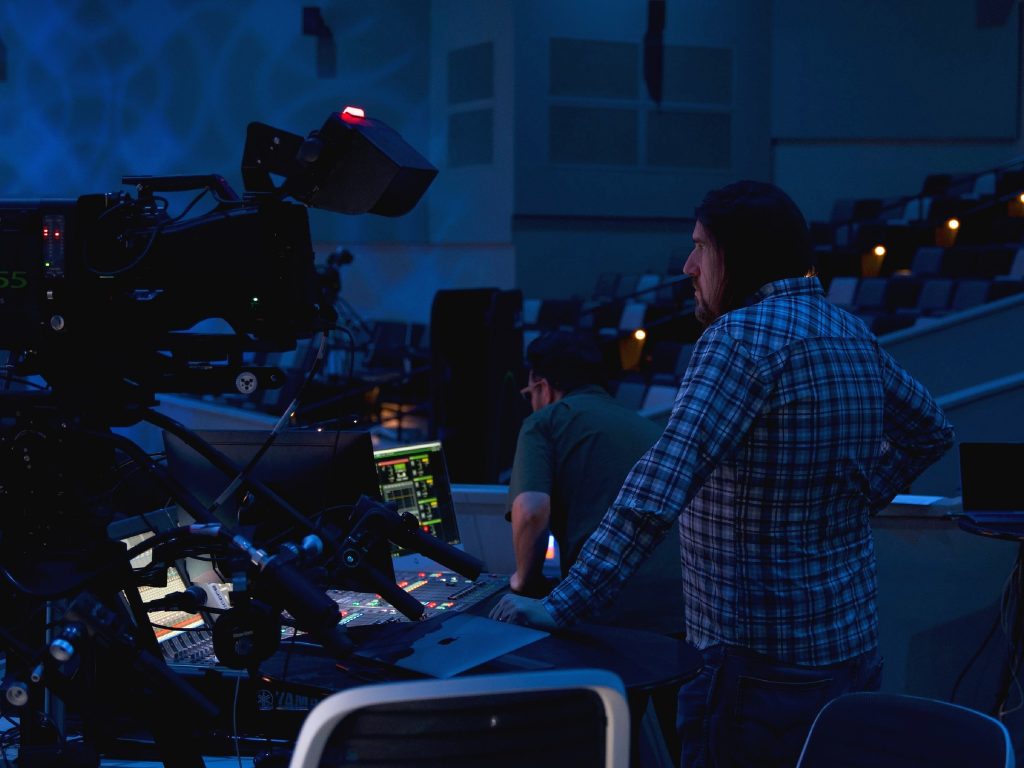
By Scott Vegte
In the world of low-voltage systems, finding the right partner is like navigating a maze of regulations, standards, and evolving technologies. This is especially true for organizations within the House of Worship sector, where the seamless integration of audio-visual, lighting, and technology solutions can be paramount to creating transformative experiences for congregations. Join us as we embark on a journey through the history and evolution of the low-voltage industry, uncovering insights to aid in selecting the ideal partner for your specific needs.
As we delve into the industry’s history, it’s essential to understand that while laws govern some aspects, standards guide others. Emerging from the electrical trades, the low voltage industry needs more uniformity of standards, a diverse ecosystem, rapid technological advancements, varied stakeholder interests, and market fragmentation. Despite these challenges, organizations like AVIXA, BICSI, and CEDIA have emerged to address these issues by providing education, training, standards development, and networking opportunities. While these organizations significantly contribute to industry advancement, competing regulatory bodies and overlapping standards create complexity and confusion.
Believe it or not, in the early days of the electrical industry, the power companies provided a turnkey solution from generation to distribution and utilization. During the late 19th and early 20th centuries, as electricity became more widely available and demand for electrical services grew, power companies played a central role in electrifying homes, businesses, and cities. They often provided the infrastructure needed to bring electricity into buildings and wire them for lighting and other electrical appliances.
Continued Evolution
Yet, as demand surged and regulations evolved, the roles of power companies and electrical contractors became more specialized. Electrical contractors emerged as independent entities specializing in installing and maintaining electrical systems, while power companies focused primarily on generating and distributing electricity. Today, while these roles may have stabilized somewhat, the low-voltage sectors continue to evolve, driven by technological advancements, changing market demands, and a push towards professionalization and specialization.
Several factors contribute to this ongoing evolution:
- Advancements in Technology
Rapid technological advancements, particularly in audio-visual, telecommunications, security, and automation, drive continuous innovation and evolution within the low-voltage sectors. New technologies and solutions emerge regularly, creating opportunities for companies to adapt and expand their offerings.
- Convergence of Systems
The convergence of traditionally separate systems, such as audio, video, lighting, and IT/networking, into integrated solutions further fuels the evolution of the low-voltage industry. Companies that can provide comprehensive, integrated solutions across multiple disciplines are well-positioned to thrive in this evolving landscape.
- Changing Market Demands
Shifts in consumer preferences, industry regulations, and market demands drive companies to evolve and diversify their services to meet changing needs. For example, the growing demand for smart home technologies, energy-efficient solutions, and cybersecurity measures creates new opportunities for companies in the low-voltage sectors.
- Professionalization and Specialization
As the industry matures, companies within the low-voltage sectors are professionalizing their operations, investing in training, certifications, and best practices to deliver high-quality services. Specialization in niche areas, such as AV integration, network infrastructure, or security systems, allows companies to differentiate themselves and provide specialized expertise to clients.
- Industry Collaboration and Partnerships
Collaboration between companies, industry associations, and technology vendors fosters innovation and growth within the low-voltage sectors. Partnerships allow companies to leverage complementary strengths, access new markets, and deliver comprehensive solutions to clients.
Challenges in the Low-Voltage Sector
The regulatory environment in the low-voltage sector differs significantly from that of the powerline and electrical industries, which are subject to stringent regulations due to life safety considerations. While regulations certainly play a crucial role in ensuring safety and standardization in electrical installations, the relative lack of regulatory oversight in the low-voltage sector contributes to a more fragmented and less standardized landscape.
Here are some factors that may contribute to the challenges in the low-voltage sector:
- Lack of Uniform Standards
Unlike the powerline and electrical industries, which adhere to well-established national and international standards, the low-voltage sector needs uniform standards across different disciplines. This lack of standardization can lead to compatibility issues, interoperability challenges, and system design and installation inconsistencies.
- Diverse Ecosystem
The low-voltage sector encompasses various technologies and applications, including audio-visual, telecommunications, security, automation, and networking. This diversity can make it challenging to develop comprehensive regulatory frameworks that address the unique requirements of each discipline.
- Rapid Technological Advancements
Technological innovation in the low-voltage sector is often faster than regulatory agencies can keep up with. As a result, regulations may lag behind emerging technologies, leaving gaps in oversight and standardization.
- Varied Stakeholder Interests
The low-voltage sector includes various stakeholders, including manufacturers, integrators, installers, consultants, and end-users. Each stakeholder group may have different priorities, interests, and perspectives on regulation and standardization, making achieving consensus on industry-wide standards challenging.
- Market Fragmentation
The low-voltage market is highly fragmented, with numerous players operating in different segments and niches. This fragmentation can lead to competition, proprietary solutions, and reluctance to adopt standardized approaches that may limit differentiation and innovation.
While the lack of regulatory oversight in the low-voltage sector presents challenges, it also offers opportunities for innovation, entrepreneurship, and flexibility. However, there is undoubtedly a need for greater collaboration, standardization, and coordination among industry stakeholders to address interoperability issues, ensure quality and reliability, and promote the professionalization of the low-voltage industry. Industry associations, partnerships, and voluntary certification programs can promote best practices and drive positive change within the sector.
Industry Organizations You Should Know
To combat the lack of regulation and incompatibilities, the professionals within their respective industries created AVIXA, BICSI, and CEDIA to address the need for education, training, standards development, and networking opportunities. These organizations promote professionalism, standardization, and innovation within the audio-visual, information, and communications technology (ICT) infrastructure and custom electronics industries.
- AVIXA (Audio-visual and Integrated Experience Association) was founded in 1939 as the National Association of Visual Education Dealers (NAVED). It originated in the United States and initially focused on promoting the use of visual aids in education. Over the years, the organization evolved to encompass a broader scope, including the audio-visual industry, and underwent several name changes. In 2013, it was rebranded as Infocomm International. Finally, in 2018, the organization adopted its current name, AVIXA, to reflect its expanded focus on integrated experiences beyond traditional AV. AVIXA is the leading trade association for the audio-visual industry, providing education, certification, standards development, market research, and networking opportunities for professionals worldwide.
- BICSI (Building Industry Consulting Service International) was founded in 1974. It originated in the United States as a professional association focused on providing education, training, certification, and standards development for professionals working in the information and communications technology (ICT) infrastructure industry. Since its establishment, BICSI has expanded its reach globally, serving as a leading authority in the field of ICT infrastructure design, installation, and management.
- CEDIA (Custom Electronic Design & Installation Association) was founded in 1989. It originated in the United States as a trade association for professionals involved in the design, installation, and integration of electronic systems in residential settings. Since its inception, CEDIA has grown into a global organization, with members and chapters worldwide, serving the custom electronics industry and promoting excellence in home technology integration.
Together, these organizations contribute significantly to advancing and professionalizing their respective industries, promoting best practices, fostering innovation, and providing valuable support to their members and the broader industry community.
However, when competing regulatory organizations oversee similar aspects of an industry, this can indeed lead to overlap, inconsistency, and complexity, which may contribute to confusion and challenges for industry professionals and certainly for customers navigating the selection of a partner.
In the AVL (Audio-Visual Lighting) industry, organizations like AVIXA, BICSI, and others have developed standards, guidelines, and best practices related to various aspects of AVL systems design, integration, and installation. While these efforts are typically aimed at promoting quality, interoperability, and professionalism within the specific industry they serve, the existence of multiple sets of standards or regulations can sometimes create confusion or conflicts, particularly when standards overlap or contradict each other.
Additionally, the AVL industry often involves integrating technologies from diverse disciplines, such as audio, video, lighting, and networking, which may fall under the purview of different regulatory organizations. This further complicates the landscape and may contribute to challenges in ensuring consistency and compatibility across AVL systems.
AVIXA, BICSI, and CEDIA are prominent organizations within the audio-visual, information, and communications technology (ICT) infrastructure, as well as the custom electronics industries. AVIXA’s core is for low-voltage specialists focused on the Arts. BICSI’s core focus is on professionals in the information and communications technology (ICT) infrastructure industry. CEDIA’s focus is on promoting excellence in residential settings.
Looking at the different origins and focuses of AVIXA and BICSI and how these differences can influence perceptions within the construction and building trades is critical in understanding the industry’s current state as a whole and should be invaluable in helping shape our future.
AVIXA-style systems, emphasizing creative design and experiential solutions, require close collaboration and direct communication with clients, owners, and end-users to ensure the final AV installations meet their needs and expectations.
AVIXA, with its roots in the world of the arts, entertainment, and performance, often brings a creative and design-oriented approach to audio-visual solutions. Its members typically have backgrounds in theater, touring, studio production, and other artistic endeavors, which can result in innovative and experiential AV designs.
Organizations must carefully evaluate potential partners in navigating this complex terrain based on their experience, expertise, and alignment with industry standards. Whether aligned with CEDIA, BICSI, or AVIXA standards, selecting the right partner ensures that audio-visual, lighting, and technology solutions meet the unique requirements of each project, from traditional worship settings to those incorporating sophisticated production elements.
AVLA Partner Guide
Experience and Expertise
Evaluate the partner’s knowledge, expertise, and years in business
References and Reputation
Check references and assess the partner’s reputation in the industry
Design Abilities
Review portfolio to assess design proficiency, innovation, and creativity
Visualization Capabilities
Assess proficiency in project predictions & visualization using software & modeling tools
Collaboration and Communication
Ensure effective collaboration and communication channels with the partner
Construction Expertise
Inquire about the firm’s industry experience, emphasizing timely, on-budget delivery
Brands Carried
Explore the partner’s brand affiliations and selection criteria
Prefabrication
Evaluate the partner’s utilization of prefabrication and the advantages it offers
Onsite Installation
Review onsite installation procedures, subcontractor involvement, and project execution
Testing, Tuning, and Training
Ensure comprehensive testing, precise tuning, and thorough training protocols
Technical Support and Maintenance
Review the partner’s technical support and maintenance offerings.
License and Certifications
Ensure the company holds the appropriate licenses and certifications
Insurance
Inquire about coverage in the event of an accident or property damage
Finance
Explore partner’s adaptable financial solutions for seamless project funding and management
Conclusion
In a traditional worship setting, contractors aligned with CEDIA or BICSI standards may benefit, as their systems tend to be simpler and more straightforward. However, for churches seeking to incorporate heavy production elements such as broadcast, lighting, and audio designed to evoke emotional responses, an AVIXA standards-based contractor would be needed.
As we conclude our expedition through the low-voltage landscape, it becomes evident that the journey is as important as the destination. By understanding the industry’s historical context and ongoing evolution, you can feel confident in making informed decisions when selecting partners to embark on your journey. So, whether you’re seeking to illuminate minds or evoke emotions, remember that choosing the right partner ensures that audio-visual, lighting, and technology solutions meet the specific requirements of each project, from traditional worship settings to sophisticated production elements.




